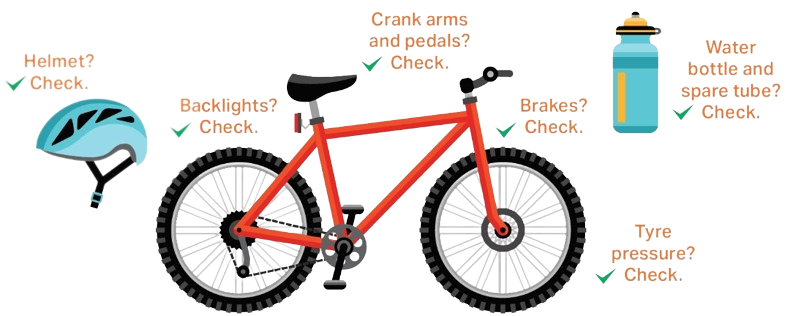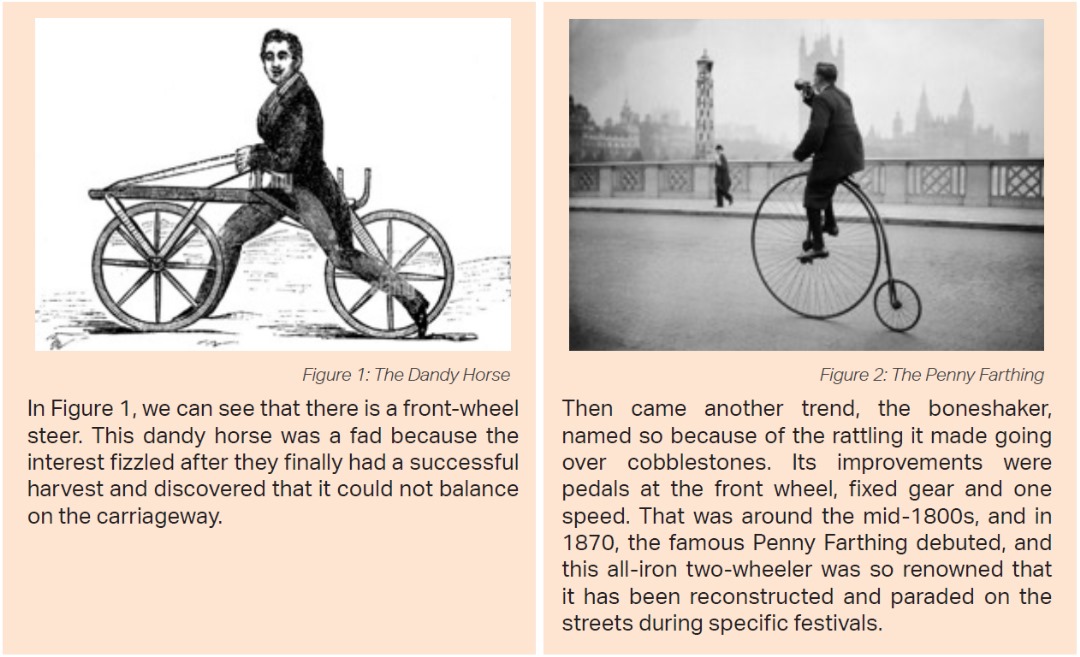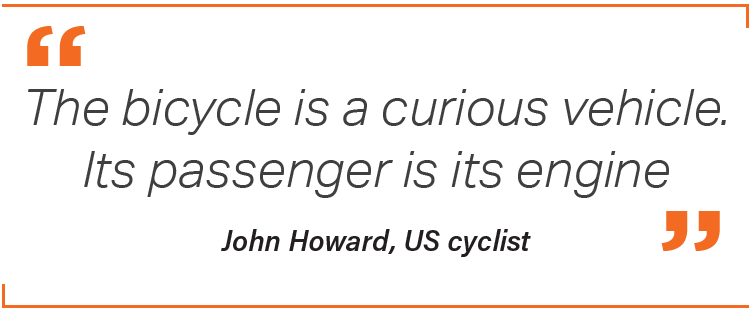by | Nik Sufini Nik Mohamed
sufini@might.org.my


All good to go on the bicycle, be it a foldable, mountain, gravel or road bike. Of course, this wonderful invention is also used by many adults to go to and from work or school, and to the grocers, or even for a parent to drop their kids off at school.
But cycling as an outdoor sport? Especially for adults aged 50 and above? Yes, why not?

Let us first look at the benefits of cycling. The late actor-comedian Robin Williams called it a mobile meditation. He was an avid cyclist. Being out in the open air improves brain functions, and if you cycle at the start of the day, bathing in the morning sun gives you healthy bursts of vitamin D. Cycling through the countryside, the kampungs, or in between oil palm plantations, allows you to enjoy the greeneries and breath in clean air. Cycling is gentle on the knees and joints, provided the bicycle you are on, is in good condition. Would brisk walking not be just as good, and provide the necessary cardiovascular movements? Though both are low-impact workouts, cycling is more intense and burns more calories. ‘Additionally, it promotes physical coordination as it involves the quadriceps and other muscles that maintain your balance’ . It is also a good endurance exercise, improves breathing and increases the heart rate.
Ultimately, it depends on your motivation level and end goal. For those above 50, we do not need to compare with the younger generations, who find thrill in speed and distance, enjoying the outdoors and landscapes as they fly by on their two-wheelers. On the contrary, we only need to live by the mantra ‘mens sana in corpore sano’ – a healthy mind in a healthy body. Relying on our trusted metal stead as a means for workouts. Regular exercise for the 50s and over, prevent us from ageing-related medical issues and cardiovascular problems, and it builds muscle strength. Still, it is a triple-helix approach, with sufficient sleep contributing 50%, a good diet 30%, and sports or exercising 20% (a formula shared by my trainer at a gym I used to frequent).
Indeed, many other activities besides cycling and brisk walking can promote healthy bodies, such as yoga, Pilates, golf, swimming and tennis. So, why focus on cycling? Simply put, cycling is not just about keeping fit and healthy. It is an option to get you from point A to point B, farther and quicker than what you could generally do with walking. Furthermore, not only is it a mobile meditation, it is also a non-polluting mode of transport . Non-polluting means it does not require fossil fuels, nor does it produce noise pollution.
As for the individual, keeping track of one’s performance and health status during cycling is now facilitated via technology, with wearables in the form of smartwatches or fitness trackers. Aside from telling time and date and having all the common features the latest smartwatch would have, it can track and manage your health and workout status, including step calculation, hiking or cycling movements, sleep patterns, heart rate measurement, etc. It is the perfect gadget for health enthusiasts.
The big question is, how much do we want to rely on smartwatches to monitor our health and any other activities one may have? In any case, health monitoring the 50s and above age groups, be it via a smartwatch or manually, is imperative to gauge if they are exerting themselves and need take a few breather from activities, amongst others.


Likewise, road bikes alone have many options, specs and price. At the turn of the 20th century, cycling became very popular, and one of every three patent applications had something to do with the bicycle! . We also have innovations and improvements in the helmet’s design that ensure comfort, lightness, cool and protected. Interestingly, we have e-bikes, which ease cycling undulating terrains. You will still need to pedal with some models, of course, because not having to pedal at all, would defeat the purpose of having a bike in the first place.
Nowadays, bicycle frames are made from carbon fibre or alloy, which makes them lighter than iron, with the lightest total weight recorded at a mere 6.8 kg! . Why would the weight of a road bike be an essential feature to mention? Because it would be easier to handle for older adults. There is no need to install a carrier on the car because the bicycle’s front wheel can be conveniently detached, and it can be put in the back seat if the rider needs to drive out to the starting point of the cycling activity.
Technology and innovation have markedly contributed to the evolution of the bicycle from when it was first invented, allowing the fad to become a trend that would keep growing, despite it dwindling for some time after motorised vehicles were designed. The trend will only grow steadily if cycling becomes a culture in our society. Cycling culture means cycling has become a mainstream mode of transport, and several countries exemplary of this culture are Denmark, the Netherlands, Belgium, Sweden, China and Japan.
Let us take one country, Japan, as an example of a nation with the best cycling culture (Source: earthbuddies.net). It is estimated that the number of bicycles in Japan is 60% of the total Japanese population of 120 million. Japan has always advocated using greener transportation; this is part and parcel of an intelligent society and what a developed country means. Aside from the Shinkansen bullet trains going at a top speed of 320 km per hour, the Japanese prefer non-automobile modes of transport and enjoy walking, commuting and cycling. Japan is an ageing society, with seniors aged 65 and above making up 28% of the population. Still, they are primarily healthy due to their fear of being a ‘meiwaku’, a Japanese word for burden, to their families and societies. According to one local associate professor in Health Management Research at the Keio Sports Medicine Research Centre, a higher cognitive ability (the brain’s skills in performing day-to-day tasks from the simplest to the most complex) results from our athletic skills. Yuko Oguma said, “there has been evidence that muscles can continue to strengthen, even in old age, which is contrary to what we believed.”
In Malaysia, there are infrastructures and dedicated cycling lanes, but there need to be more, so that cycling can become a mode of transportation. One big concern for Malaysians is safety, as we do not have sufficient dedicated cycling tracks. Therefore, a safe and adequate infrastructure can entice more Malaysians to cycle. Once it becomes a culture, at every opportunity and convenience, we will use the bike for our short traverses through the concrete jungle to get bread or a meal, visit a neighbour for as long as the weather permits, or go to work. These activities can contribute to working out. For the more enthusiastic, joining a cycling club or participating in cycling events, would be additional activities.

In consideration of contributing to a healthier environment and a healthier population, the future looks bright for cycling as a healthy option for outdoor sports and technology will keep improving the design, quality and make of the bicycle, to give us better experiences in cycling. Like any other solutions or products on the market, bicycles come in multiple ranges of specifications and prices, from the low and medium, to the highest ranges. Hence, it does not mean we will not be able to pedal well if we buy a lower-range brand because the strength comes from the legs that push the pedals and our cadence, ie in cycling terms, it means the number of revolutions per minute we complete at a given speed.
More and more people over 50 are embracing a healthier lifestyle, as reported, for example, by the National Health Service of England. In fact, a 2018 study suggests that cycling can ward off the effects of ageing and keep your immune system strong and found that the t-cells of older cyclists were generated as much as that of younger people. Studies from the King’s College London and the University of Birmingham found that cyclists over 55 ‘has levels of physiological function that would place them at a much younger age than the general population’. These statements should be good enough to entice not just the 50s and above to get on the saddle and pedal, but people of all ages too.









